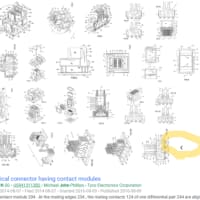US10959279
TECHNICAL FIELD
【技術分野】
【0001】
[0002] Embodiments herein relate to a User Equipment (UE), a network node and methods therein.
本明細書の実施形態は、ユーザ装置(UE)、そのネットワークノード、および方法に関する。
In some aspects, they relate to handling a Radio Link Failure (RLF on a first group of cells in a wireless communication network.
いくつかの態様では、それらは、無線通信ネットワークにおける第1のセルグループ上の無線リンク障害(RLF)を処理することに関する。
BACKGROUND
【背景技術】
【0002】
[0003] In a typical wireless communication network, wireless devices, also known as wireless communication devices, mobile stations, stations (STA) and/or User Equipments (UE),
典型的な無線通信ネットワークでは、無線通信装置、移動局、ステーション(STA)および/またはユーザ装置(UE)とも呼ばれる無線デバイスは、
communicate via a Local Area Network such as a Wi-Fi network or a Radio Access Network (RAN) to one or more core networks (CN).
Wi-Fiネットワークまたは無線アクセスネットワーク(RAN)などのローカルエリアネットワークを介して1つまたは複数のコアネットワーク(CN)と通信する。
The RAN covers a geographical area which is divided into service areas or cell areas,
RANは、サービスエリアまたはセルエリアに分割される地理的領域を含み、
which may also be referred to as a beam or a beam group,
それらは、ビームまたはビームグループとも呼ばれうる、
with each service area or cell area being served by a radio network node such as a radio access node e.g., a Wi-Fi access point or a radio base station (RBS), which in some networks may also be denoted, for example, a NodeB, eNodeB (eNB), or gNB as denoted in 5G.
たとえば、Wi-Fiアクセスポイントまたは無線基地局(RBS)など、いくつかのネットワークにおいては、たとえば、NodeB、eNodeB (eNB)と表記され、または、5GではgNBなどと表記されるような、無線アクセスノードなどの、無線ネットワークノードによってサービスを提供されるサービスエリアまたはセルエリアである。
A service area or cell area is a geographical area where radio coverage is provided by the radio network node.
サービスエリアまたはセルエリアは、無線ネットワークノードによって無線カバレッジを提供される地理的領域である。
The radio network node communicates over an air interface operating on radio frequencies with the wireless device within range of the radio network node.
無線ネットワークノードは、無線周波数で動作するエアインターフェースを介して、無線ネットワークノードの範囲内の無線デバイスと通信する。
[0004] Specifications for the Evolved Packet System (EPS), also called a Fourth Generation (4G) network, have been completed within the 3rd Generation Partnership Project (3GPP)
【0003】
第4世代(4G)ネットワークとも呼ばれる進化型パケットシステム(EPS)の仕様は、第三世代パートナーシッププロジェクト(3GPP)内で完了しており、
and this work continues in the coming 3GPP releases, for example to specify a Fifth Generation (5G) network also referred to as 5G New Radio (NR).
この作業は、たとえば、5G New Radio (NR)とも呼ばれる第5世代(5G)ネットワークを指定するために、来るべき3GPPリリースにおいて継続する。
The EPS comprises the Evolved Universal Terrestrial Radio Access Network (E-UTRAN), also known as the Long Term Evolution (LTE) radio access network,
EPSは、ロングタームエボリューション(LTE)無線アクセスネットワークとしても知られている進化型ユニバーサル地上無線アクセスネットワーク(E-UTRAN)と、
and the Evolved Packet Core (EPC), also known as System Architecture Evolution (SAE) core network.
システムアーキテクチャエボリューション(SAE)コアネットワークとしても知られている進化型パケットコア(EPC)とを有する。
E-UTRANILTE is a variant of a 3GPP radio access network wherein the radio network nodes are directly connected to the EPC core network rather than to RNCs used in 3G networks.
E-UTRAN/LTEは、無線ネットワークノードが、3Gネットワークで使用されるRNCではなく、EPCコアネットワークに直接的に接続される、3GPP無線アクセスネットワークの変形である。
In general, in E-UTRAN/LTE the a 3G RNC are distributed between the radio network nodes, e.g. eNodeBs LTE, and the core network.
概して、E-UTRAN/LTEでは、3G RNCの機能は、無線ネットワークノード、たとえば、LTEにおけるeNodeBと、コアネットワークとの間で分散される。
As such, the RAN of an EPS has an essentially “flat” architecture comprising radio network nodes connected directly to one or more core networks, i.e. they are not connected to RNCs.
したがって、EPSのRANは、1つまたは複数のコアネットワークに直接的に接続された、すなわち、RNCに接続されていない無線ネットワークノードを備える、本質的に「フラット」なアーキテクチャを有する。
To compensate for that, the E-UTRAN specification defines a direct interface between the radio network nodes, this interface being denoted the X2 interface.
これを補うために、E-UTRAN 規格では無線ネットワークノード間のダイレクトインターフェースが定義されており、このインターフェースはX2 インターフェースと表記される。
[0005] Multi-antenna techniques(*無冠詞複数;個々の具体的技術)can significantly increase the data rates and reliability of a wireless communication system.
【0004】
マルチアンテナ技術は、無線通信システムのデータ速度および信頼性を大幅に向上させることができる。
The performance is in particular improved if both the transmitter and the receiver are equipped with multiple antennas, which results in a Multiple-Input Multiple-Output (MIMO) communication channel.
送信機と受信機の両方が複数のアンテナを備えている場合、多入力多出力(MIMO)通信チャネルが生じ、特に性能が改善される。
Such systems and/or related techniques are commonly referred to as MIMO.
このようなシステムおよび/または関連技術は、一般にMIMOと呼ばれる。
[0006] NR Standalone
【0005】
NRスタンドアロン型(独立型)
[0007] in NR non-standalone a 5G networks will be supported by existing 4G infrastructure or 5G infrastructure and in NR standalone a 5G networks will be supported by only a 5G infrastructure.
NR非スタンドアロン型では、5G ネットワークは既存の4Gインフラストラクチャまたは5Gインフラストラクチャによってサポートされるが、NRスタンドアロン型では5Gネットワークは5Gインフラストラクチャのみによってサポートされる。
[0008] In NR standalone, but more in general in NR, an NG-RAN node is a gNB(*不定冠詞;具体)providing NR user plane and control plane protocol terminations towards a UE(*不定冠詞).
【0006】
NRスタンドアロンではあるが、より一般的にはNRでは、NG-RANノードは、UEに向けてNRユーザプレーンおよび制御プレーンプロトコルターミネーション(終端)を提供するgNBである。
Alternatively, in case of LTE connected 5GC core network, an NG-RAN node is a ng-eNB, providing E-UTRA user plane and control plane protocol terminations towards the UE(*定冠詞;上記の;別に不定冠詞でもいいはず).
あるいは、5GCコアネットワークに接続されたLTEのケースでは、NG-RANノードは、E-UTRAユーザプレーンおよび制御プレーンプロトコル終端をUEに提供するng-eNBである。
[0009] FIG. 1 shows the User Plane Protocol Stack for the NR user plane,
【0007】
図1に、NRユーザプレーンのユーザプレーンプロトコルスタックを示す。
with Service Data Adaptation Protocol (SLAP)(*無冠詞;概念としての技術), Packet Data Convergence Protocol (PDCP), Radio link control (RLC) and Medium Access Control (MAC), and Physical Layer (PHY) sublayers, terminated in gNB on the network side.
サービスデータアダプテーションプロトコル(SDAP)、パケットデータコンバージェンスプロトコル(PDCP)、無線リンク制御(RLC)、媒体アクセス制御(MAC)、および物理レイヤ(PHY)などのサブレイヤは、ネットワーク側のgNB で終端される。
PHY in FIG. 1 stands for Physical Layer.
図1のPHYは、物理レイヤを表す。
[0010] The(*定冠詞;one and only、当業者には分かるはず、説明不要のはず、聞かないでね、そこ重要じゃないはず)NR control plane architecture is shown in FIG. 2 with a UE, a gNB, a Mobility Management Function (AMF), and the layers: Non Access Stratum (NAS), Radio Resource Control (RRC), PDCP, RLC, MAC and PHY.
【0008】
NR制御プレーンアーキテクチャは、UE、gNB、モビリティ管理機能(AMF)、およびレイヤ(非アクセスストラタム(NAS)、無線リソース制御(RRC)、PDCP、RLC、MAC、PHY)とともに、図2に示されている。
[0011] Carrier Aggregation (CA)
【0009】
キャリアアグリゲーション(CA)
[0012] When CA(*無冠詞)is configured, a UE only has one RRC connection with the network.
CA が設定されている場合、UE は、ネットワークとのRRCコネクションを1つしか有していない。
Further, at(*=upon)RRC connection establishment, re-establishment and/or handover, one serving cell provides the NAS mobility information, and at RRC connection re-establishment and/or handover, one serving cell provides the security input.
さらに、RRCコネクションの確立、再確立および/またはハンドオーバの際には、1つのサービングセルがNASモビリティ情報を提供するが、RRCコネクションの再確立および/またはハンドオーバの際には、1つのサービングセルがセキュリティ入力を提供する。
This cell is referred to as the Primary Cell(*定冠詞)(P Cell). In addition, depending on UE capabilities, Secondary Cells (SCells) may be configured to form together with the PCell a set of serving cells.
このセルは、プライマリセル(PCell)と呼ばれる。さらに、UEの能力に応じて、セカンダリセル(SCell)は、PCellとともにサービングセルのセットを形成するように設定(構成)されうる。
The configured set of serving cells for a UE therefore comprises one PCell and one or more SCells.
したがって、UE 用のサービングセルの構成されたセットは、1つのPCell と1つまたは複数のSCellを有する。
Further, when dual connectivity is configured, it may be the case that one carrier under the Secondary Cell Group (SCG) is used as the Primary SCell (PSCell).
また、デュアルコネクティビティを構成する場合には、プライマリSCell (PSCell)として、セカンダリセルグループ(SCG)下の1つのキャリアを使用する場合がある。
Hence, in this case there may be one PCell and one or more SCell(s)(*カッコs要る?単に複数で良いんじゃ?)over a Master Cell Group (MCG) and one PSCell and one or more SCell(s) over the SCG.
したがって、この場合、マスタセルグループ(MCG)上に1つのPCellおよび1つまたは複数のSCellが存在し、SCG上に1つまたは複数のPSCellおよび1つまたは複数のSCellが存在しうる。
[0024] Radio Link Failure
【0012】
無線リンク障害
[0025] In LTE, a UE considers a RLF to be detected when:
LTEで、UEは、以下の場合に検出されるべきRLFについて考慮する:
i. Upon detecting, a certain number of out of sync indications from the lower layers associated with the PCell within a given time, or
i. 所与の期間内にPCellに関連付けられている下位レイヤからの同期外れインジケーションが所定回数検出されたとき、または、
ii. upon random access problem indication from MAC, or
ii. MACからのランダムアクセス問題インジケーションがあったとき、または、
iii. UI upon indication from RLC that the maximum number of retransmissions has been reached for a Signaling Radio Bearer (SRB) or for a Data Radio Bearer (DRB).
iii. RLCから、シグナリング無線ベアラ(SRB)またはデータ無線ベアラ(DRB)について再送信回数が最大値に達したことを示すインジケーションがあったとき。
[0055] PUCCH on SCell
【0024】
SCell上のPUCCH
[0056] Since CA aggregates multiple independent carriers for parallel and simultaneous communications, scheduling and data transmission and/or reception are done independently by each Component Carriers (CC).
CAは、パラレルおよび同時並行的な通信のために、複数の独立したキャリアをアグリゲーション(集約)するため、スケジューリングおよびデータ送信および/または受信は、各コンポーネントキャリア(CC)によって独立して行われる。
Hence, most of the conventional and non-CA LTE functions may be reused for each CC.
したがって、従来型および非CA LTE機能の大部分は、各CCに対して再利用される可能性がある。
On the other hand, in Release 12 CA, only the Primary Cell) supports the PUCCH that transmits Uplink Control Information (UCI) such as ACKnowledgement (ACK)/Negative ACK (NACK) for all the downlink CCs and Channel State Information (CSI) for all the downlink CCs, and Scheduling Requests (SR) for uplink.
一方、リリース12のCAでは、全てのダウンリンクCCに対するアクノレッジメント(ACK)/ネガティブアクノレッジメント(NACK)、全てのダウンリンクCCに対するチャネル状態情報(CSI)、およびアップリンクに対するスケジューリングリクエスト(SR)などのアップリンク制御情報(UCI)を伝送するPUCCHを、プライマリセル (PCell)のみが、サポートする。
This is to avoid mandating more than one uplink CC in CA.
これは、CAにおいて2つ以上のアップリンクCCを義務化することを回避するためである。
Furthermore, having PUCCH on PCell only allows the U E to use the unified UCI transmission framework regardless of its uplink CA capability.
さらに、PCell上にPUCCHを有することは、UEが、そのアップリンクCA能力にかかわらず、統一されたUCI送信フレームワークを使用することを可能にするだけである。
However, if a certain LTE carrier is used as the PCell for many UEs configured with CA, there may be a shortage of uplink radio resources due to the increased PUCCH load on that carrier.
しかしながら、CAを構成される多くのUEのためのPCellとして、あるLTEキャリアが使用される場合、そのキャリア上の増加したPUCCH負荷のために、アップリンク無線リソースが不足することがありうる。
A typical example is CA operating on heterogeneous networks where many small cells are deployed in the coverage of a macro cell.
典型的な例は、多くの小さなセルがマクロセルのカバレッジ内に配置される異種ネットワーク上で運用されるCAである。
The relatively low-powered small cells are deployed in high traffic areas with different frequencies from that of the macro cell.
比較的に低電力の小セルは、マクロセルの周波数とは異なる周波数を有する高トラフィックエリアに配置される。
In areas where these small cells are overlaid on the macro cell, the UTE may be configured with CA for the small cells and the macro cell.
これらの小セルがマクロセル上にオーバーレイされるエリアでは、UEは、小セルおよびマクロセルのためのCAを設定(構成)されうる。
[0063] Network nodes operate in the wireless communications network 100 such as a first network node 111 and a second network node 112 .
【0031】
ネットワークノードは、第1のネットワークノード111および第2のネットワークノード112のように、無線通信ネットワーク100内で動作する。
The first network node 111 provides radio coverage over a geographical area, a service area referred to as a first group of cells 115 第1のネットワークノード111は、地理的領域である、第1のセルグループ115と呼ばれるサービスエリアにわたって無線カバレッジを提供し、
e.g. comprising one or more first cells such as one or more PCells, which may also be referred to as a beam or a beam group of first radio access technology (RAT), such as 5G, LTE, Wi-Fi or similar.
これは、たとえば、1つまたは複数のPCellなどの1つまたは複数の第1のセルを含み、これは、5G、LTE、Wi-Fiまたはその類似技術などの第1の無線アクセス技術(RAT)のビームまたはビームグループとも呼ばれうる。
The second network node 112 also provides radio coverage over a geographical area, a service area referred to as a second group of cells 116
また、第2のネットワークノード112は、地理的領域である、第2のセルグループ116と呼ばれるサービスエリアにわたって無線カバレッジ提供し、
e.g. comprising one or more second cells such as one of more SCells, which may also be referred to as a beam or a beam group of first radio access technology (RAT), such as 5G, LTE, Wi-Fi or similar.
これは、たとえば、1つまたは複数のSCellのような1つまたは複数の第2のセルを含み、これは、5G、LTE、Wi-Fiまたはその類似技術などの第1の無線アクセス技術(RAT)のビームまたはビームグループと呼ばれうる。
The first and second network nodes 111 , 112 may each be
第1および第2のネットワークノード111、112は、それぞれ、
a NR-RAN node, transmission and reception point e.g, a base station, a radio access network node such as a Wireless Local Area Network (WLAN) access point or an Access Point Station (AP STA),
NR-RANノード、送信および受信ポイント、たとえば、無線ローカルエリアネットワーク(WLAN)アクセスポイントまたはアクセスポイントステーション(AP STA)のような無線アクセスネットワークノード、
an access controller, a base station, e.g. a radio base station such as a NodeB, an evolved Node B (eNB, eNode B), agNB, a base transceiver station, a radio remote unit, an Access Point Base Station, a base station router, a transmission arrangement of a radio base station, a stand-alone access point
アクセスコントローラ、基地局、たとえば、ノードBのような無線基地局、進化型ノードB(eNB、eノードB)、agNB、ベーストランシーバー局、無線リモートユニット、アクセスポイント基地局、基地局ルータ、無線基地局の送信アレンジメント、スタンドアロン型アクセスポイント、
or any other network unit capable of communicating with a wireless device within the service area sewed by the respective first and second network node 111 , 112
または、使用される第1および第2のネットワークノード111、112のそれぞれによってサービスを提供されるサービスエリア内の無線デバイスと通信することができる他の任意のネットワークユニットであり、
depending e.g. on the first radio access technology and terminology used.
これらは、たとえば、第1の無線アクセス技術および使用される用語に依存する。
The respective first and second network node 111 , 112 network nodes may be referred to as serving radio network nodes and communicates with a UE with Downlink (DL) transmissions to the UE and Uplink (UL) transmissions from the UE.
第1および第2のネットワークノード111、112といったそれぞれのネットワークノードは、UEへのダウンリンク(DL)送信およびUEからのアップリンク(UL)送信によりUEと通信する、サービング無線ネットワークノードとして参照されてもよい。
Thus, the differentiation of which carrier is experiencing bad radio conditions may not be that relevant.
したがって、どのキャリアが悪い無線状態を経験しているかの区別は、それほど重要ではない場合がある。
[0068] Further, this is especially relevant for NR due to the wide range of frequencies that may be used, spanning from 100s of MHz up to 100 GHz, thus resulting in a wide range of different channel behavior under the same network conditions.
【0036】
さらに、これは、使用されうる周波数の幅が数100MHzから100GHzに及ぶNRに特に関連しており、同じネットワーク条件下であっても広範囲の様々なチャネル挙動をもたらすことがある。
Therefore, in case of CA level duplication on NR, the UE 120 may use different frequencies in the carriers being used for duplication that are quite far to each other when considering the overall radio spectrum.
したがって、NR上でのCAレベルの複製の場合には、UE120は、全体的な無線スペクトルを考慮するときに、複製に使用される互いにかなり離れたキャリアで異なる周波数を使用することがありうる。
[0092] In some embodiments, upon the RLF detection, the UE 120 may start a Radio Link Monitoring (RLM), on at least one of the SCells.
【0053】
いくつかの実施形態において、RLF検出時に、UE120は、少なくとも一つのSCell上で、無線リンク監視(RLM)を開始してもよい。
[0152] In one of the examples, upon receiving the PCell-RLF, the network node 111 , 112 , 130 sends a RRC connection re-configuration message to the UE 120 to communicate the new radio configuration, which may include the configuration of a new PCell.
【0102】
一例では、PCell-RLFを受信すると、ネットワークノード111、112、130は、新しいPCellのコンフィギュレーション(構成)を有することができる新しい無線構成を通信するために、RRCコネクション再構成メッセージをUE120に送信する。
[0157] The network node 111 , 112 , 130 and the UE 120 may comprise a respective input and output interface 700 , 800 configured to communicate with each other, see FIGS. 7 and 8.
【0107】
ネットワークノード111、112、130およびUE120は、互いに通信するように構成されたそれぞれの入出力インターフェース700、800を備えてもよい(図7および図8参照)。
The respective input and output interface 700 , 800 may comprise a wireless receiver (not shown) and a wireless transmitter (not shown).
それぞれの入出力インターフェース700、800は、無線受信機(図示せず)および無線送信機(図示せず)を備えてもよい。
[0164] In some embodiments, a respective carrier 880 780 comprises the respective computer program,
【0113】
いくつかの実施形態では、それぞれのキャリア880、780は、それぞれのコンピュータプログラムを備え、
wherein the carrier is one of an electronic signal, an optical signal, an electromagnetic signal, a magnetic signal, an electric signal, a radio signal, a microwave signal, or a computer-readable storage medium.
キャリアは、電気信号、光信号、電磁信号、磁気信号、電気的信号、無線信号、マイクロ波信号、またはコンピュータ可読記憶媒体のうちの1つである。
*「無線」に対応するradio, wirelessの使い分けは多分慣例に従うしかないのでしょう(どちらでもいい場合もあると思います)。
radio:
無線リンク障害:radio link failure, RLF
無線リンク監視:radio link monitoring, RLM
無線リンク制御:radio link control, RLC
無線アクセスネットワーク:radio access network, RAN
無線アクセス技術:radio access technology, RAT
無線ネットワークノード:radio network node
無線アクセスノード:radio access node
無線基地局:radio base station, RBS
無線カバレッジ:radio coverage
無線周波数:radio frequency
無線リソース制御:radio resource control, RRC
アップリンク無線リソース:uplink radio resource
無線状態:radio condition
無線スペクトル:radio spectrum
無線ベアラ:radio bearer
無線信号:radio signal
wireless:
無線通信ネットワーク:wireless communication network
無線デバイス:wireless device
無線LAN:wireless LAN
無線受信機(送信機):wireless receiver (transmitter)


























※コメント投稿者のブログIDはブログ作成者のみに通知されます